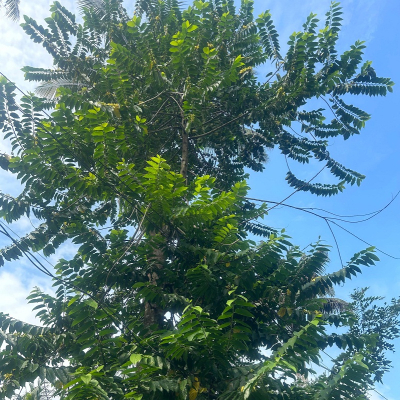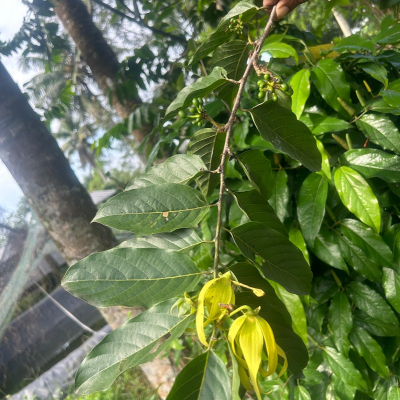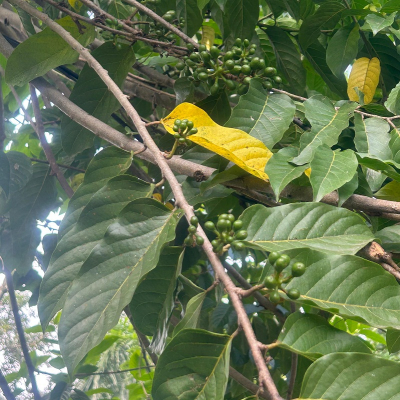Distribution and Habitat: Original home of Cananga is probably south east Asia, although it is now naturalized in Burma, Malaysia, Indonesia, Papua New Guinea and other Pacific islands and Philippines. Cananga is introduced into tropical countries in Africa, Asia, the Caribbean, the Americas and the then French colonies of Indian Ocean, specifically as an essential oil plant. Commercial cultivation and oil production are now concentrated in Indonesia and Madagascar with small amounts of oil from Reunion Comoro and Philippines.
Botany: Genus Cananga has two species; C. odorata, the source of cananga and ylang-ylang oil and C. latifolia Gins Gay Nep., producing an oil of commercial importance. Name of the tree indicates drooping nature of flowers.
- Leaves: Numerous, thin, alternate leaves with a sharply pointed apex, base rounded, margin entire, 15-20 x 4-7 cm on light green petioles.
- Flowers: Numerous, large, yellow-green flowers strongly scented and borne on slender light green stalks in axillary clusters. Individual flowers bear a narrow pendulous structure composed of three ovate-hairy sepals and six almost lanceolate petals with slightly recurved tips, 4-8 cm in length, arranged in two rows. Flower center is composed of separate carpels arranged in two series, each carpel containing a single ovule developing into separate fruit.
Properties: Anti-rheumatism, anti- malarial, anti-diarrhoeal
Chemical constituents: Geraniol and linalool
Uses (diseases): It is used in Gout, boils, opthalmia
Agrotechnology
Soil and climate: The tree requires a moist tropical climate. It grows well in rich volcanic soils or fertile sandy loams. In Java, cananga tree occurs largely wild and is planted occasionally. Propagation is largely by seeds. Seeds are sown in a seed bed in March. After 3-4 months, seedlings are planted in a polythene bag and watered frequently. Four to six months old seedlings are planted in main field at a spacing of 6 x 6 m. Plants are to be shaded in summer.
Propagation: Propagation usually takes place spontaneously by means of fruit (seed) falling off the trees or by birds eating the fruit and dropping the seed elsewhere. Natives may find a spontaneously growing young plant and they transplant it to garden without giving it any special care. Rarely and only when prices of cananga oil are very attractive, natives plant new trees grown from one year old seeds. Fresh seeds do not germinate well. During rainy season, seed is planted into holes and fertilized with cow dung. Young plants develop more or less rapidly, depending upon climate. At low altitudes, trees require only a few years to give an economic flower harvest, but at higher and cooler altitudes (500 m above MSL) they grow much more slowly and require seven to ten years to produce flowers in quantities sufficient for harvesting.
After two years first bunch of flowers appear. By beginning of third year, the trees would have achieved a height of 2-3 m and then topped. This removal of epical dominance encourages side shoot formation into lateral branches. Periodic pruning has to be undertaken to prevent growth of the tree beyond 2-3 m height. Commercial production of flowers starts from fourth year of planting. Economic life span goes up to 25 years for a well managed plantation
Pests and diseases: No serious pest or disease is noticed in the plant.
Harvesting: Trees of more than twenty years old reach a height of about 30 m. Trees flower from second year, when a small harvest may be taken and flower profusely from fourth or fifth year. A seven year old tree bears 30 to 100 kg of flowers per year. A fully grown tree produces up to 300 kg of flowers depending on climatic conditions.
Though the tree flowers throughout year, three main flowering seasons are seen for commercial production of oil. Principal season is immediately after rainy season, a moderate harvest season during dry season and rainy season. Flowers contain more essential oil during night, particularly just before day break and hence harvesting is done during early morning hours. Flowers are manually harvested and only fully developed yellow flowers are gathered. Great care is to be taken not to crush the flowers during harvest.
Flowers have little fragrance initially. Fine white hairs covering green petals disappear with maturity. After 14-21 days, petals become pale green, then yellow and their scent becomes progressively stronger. When two small reddish spots appear on base of petals, the flowers are ready for picking. This should be as early in morning as possible, when oil content is highest and normally ceases by 10 am as in strong sunlight, oil content rapidly diminishes. Composition and characteristics of oil change as flowers develop, with light oxygenated compounds the highest at maturity; thus inclusion of immature flower is detrimental to oil quality.
Processing: Flowers should be immediately distilled for oil since flowers tend to fade and ferment on keeping. Fractional distillation of oil is carried out normally. First fraction of the oil contains most of the aromatic constituents of oil such as esters and ethers, whereas later fractions consist chiefly of sesquiterpenes which have little odour value. In retort, water is taken and heated to about 70 ̊C and then flowers are quickly put into retort. Distillation is started slowly by carefully injecting live steam through perforated steam coil. The volatile oil distills out easily and first fraction which consists chiefly of esters and ethers are collected in oil separator. After a while, direct steam is shut off, distillation being continued by heating with indirect steam. Fractions are cut according to specific gravity into extra (0.955), first (0.942), second (0.922) and third fractions (0.910-0.912). Distillation is continued for a period of about 18-22 hours. Yield of oil ranges from 2-2.5%.
Distillation is done frequently in small and direct-fired water stills. Heating water to near boiling prior to adding flowers results in higher quality oil. Still bodies should preferably be under charged with flowers, since this reduces spot fermentation or over heating either being detrimental to oil quality. Distillation by any method must be carefully controlled since oil fractions in distillate have different characteristics and market value.
Weight of flowers to produce 1 kg crude oil varies from 350-700 kg depending mainly on time of year and flower maturity. In a modern distillery, a total yield of 2.0-2.5% is usual, about 25-30% being the first two grades. Flowers can be solvent extracted with petroleum either or benzene to give a yield up to 1.2% and resultant concentrate has an odour virtually identical to natural flower. Air-drying of Philippine flowers for 1 to 7 days before distilling changes specific gravity (20oC) from 0.03-0.96 to 0.913-0.914 and ester number from 120-190 to 145-150. In general, specific gravity, total esters and saponification number decrease, while optical rotation significantly increases with decrease in grade. Lower grades are virtually insoluble in 90% alcohol.





